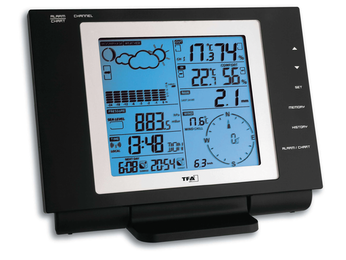Access data from a weather station with the Raspberry Pi
Weather Watch

If you have a weather station that allows you to access data via a USB port, you can use your Raspberry Pi to analyze the data and publish the results via a web application.
My new weather station [1] has several sensors for wind, rain, and temperature, as well as a USB cable and evaluation software (Figure 1), albeit a desktop-only Windows application. However, I wanted to record the measured data and, if possible, access it on my cell phone while I was on the move.
 Figure 1: The electronic TFA Nexus weather station records wind, rain, and outdoor temperature and outputs the data via USB. (Image: TFA Dostmann)
Figure 1: The electronic TFA Nexus weather station records wind, rain, and outdoor temperature and outputs the data via USB. (Image: TFA Dostmann)
Positioning a Windows PC running 24/7 next to my weather station was not an option; instead, I set my sights on the Raspberry Pi. Thus far, I had used it as a tiny media center with an equally tiny speaker, but by using its USB connection, my Pi could read the data output from the weather station. The power requirement is negligible compared with that of a full-size PC, and the Pi is silent. The question then arose: How can I acquire the data via USB if the station only comes with a Windows program?
[...]
Buy this article as PDF
(incl. VAT)
Buy Linux Magazine
Subscribe to our Linux Newsletters
Find Linux and Open Source Jobs
Subscribe to our ADMIN Newsletters
Support Our Work
Linux Magazine content is made possible with support from readers like you. Please consider contributing when you’ve found an article to be beneficial.

News
-
OpenMandriva Lx 6.0 Available for Installation
The latest release of OpenMandriva has arrived with a new kernel, an updated Plasma desktop, and a server edition.
-
TrueNAS 25.04 Arrives with Thousands of Changes
One of the most popular Linux-based NAS solutions has rolled out the latest edition, based on Ubuntu 25.04.
-
Fedora 42 Available with Two New Spins
The latest release from the Fedora Project includes the usual updates, a new kernel, an official KDE Plasma spin, and a new System76 spin.
-
So Long, ArcoLinux
The ArcoLinux distribution is the latest Linux distribution to shut down.
-
What Open Source Pros Look for in a Job Role
Learn what professionals in technical and non-technical roles say is most important when seeking a new position.
-
Asahi Linux Runs into Issues with M4 Support
Due to Apple Silicon changes, the Asahi Linux project is at odds with adding support for the M4 chips.
-
Plasma 6.3.4 Now Available
Although not a major release, Plasma 6.3.4 does fix some bugs and offer a subtle change for the Plasma sidebar.
-
Linux Kernel 6.15 First Release Candidate Now Available
Linux Torvalds has announced that the release candidate for the final release of the Linux 6.15 series is now available.
-
Akamai Will Host kernel.org
The organization dedicated to cloud-based solutions has agreed to host kernel.org to deliver long-term stability for the development team.
-
Linux Kernel 6.14 Released
The latest Linux kernel has arrived with extra Rust support and more.

